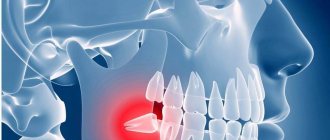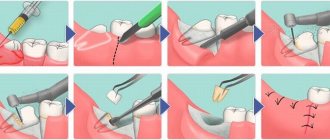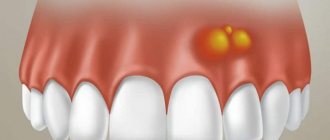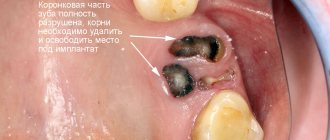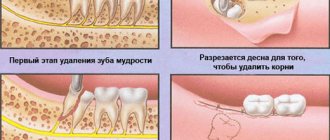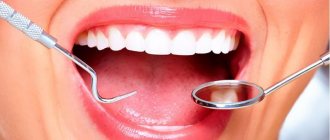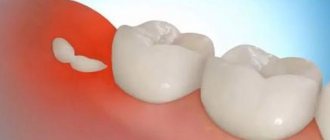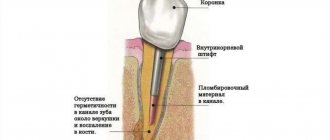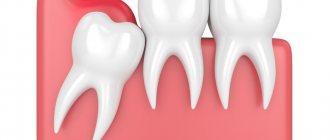Patients often face a situation where a wisdom tooth becomes ill, or we hear that someone will have their wisdom tooth removed. Let's take a closer look at this problem. What are wisdom teeth? About how problems of wisdom teeth are solved in family dentistry - in the article by the chief physician of the center Tsukor S.V.
This article will discuss one of the problems that arises with wisdom teeth and is most often encountered in the practice of dentists - asymptomatic diseases of the wisdom tooth.
Such diseases of the wisdom tooth occur without symptoms and harm the seventh tooth. The wisdom tooth does not bother the patient in any way, but the consequences of the disease and inflammation can appear at any time and bring a lot of trouble to the person.
A wisdom tooth that does not manifest itself in any way, does not bother or hurt, often does not attract the attention of a dentist. This happens, first of all, because the doctor in most cases is focused on the patient’s complaints. In some clinics, performing a comprehensive oral examination is not standard. In many dental centers, patients are not given a panoramic photo, which helps to identify hidden dental problems.
The Dial-Dent dental clinic practices a comprehensive examination of patients using the most modern diagnostic devices. This undoubtedly improves the quality of treatment, allows you to find problems hidden from the patient and begin treatment in a timely manner.
Let's consider 3 clinical cases on the topic “Removal of a wisdom tooth” from the practice of the chief dental physician S.V. Tsukor.
- Clinical case No. 1 Asymptomatic wisdom tooth - remove the 8th tooth, save the 7th tooth
- Clinical case No. 2 Removal of a wisdom tooth before implantation of the 6th tooth
- Clinical case No. 3 An incorrectly grown wisdom tooth harms the 7th tooth
Clinical case No. 1
Features of lower wisdom tooth removal
“Eights” on the lower jaw appear by the age of 20-25, when the main row of teeth is already formed and fully performs its functions. Therefore, the process of “growing” extreme molars is often not very pleasant and is accompanied by various difficulties, ranging from slight discomfort to serious destructive processes in the jaw. In this case, dentists are guided by the principle “seven troubles - one answer”: no matter what problems a wisdom tooth brings, there is only one way to get rid of them - removal.
Indications for surgery
So when is it necessary to remove a wisdom tooth in the lower jaw? In most cases, indications for surgery are related to certain pathologies of the lower “eight”.
- The wisdom tooth erupted incorrectly
- that is, not straight up, but with a deviation, at an angle to the jaw and neighboring teeth. The slope of the figure eight is:
- distal
- when the “eight” is tilted back, away from the “seven”. In this case, there is a risk of injury to the gums and damage to the roots of the adjacent tooth; - medial
- when the “eight”, on the contrary, is inclined towards the adjacent tooth. This increases the likelihood of damage to the crown part of the “seven” and the development of caries on both teeth; - buccal
- in this case, the wisdom tooth is turned towards the cheek and constantly touches the mucous membrane, causing irritation and hardening of the tissues. This condition can eventually lead to the formation - tumors on the mucosa.
- lingual
- when the tooth is tilted inward, it touches the tongue and damages it, making it difficult to eat and communicate.
- The wisdom tooth has erupted partially or not at all
- dentists call this condition partial or complete retention.
- With complete retention,
the molar does not come to the surface, remaining under the gum, inside the jaw. An impacted tooth may not show itself in any way - in this case, only regular treatment is indicated for control. However, in some cases, a “hidden” molar can cause a lot of problems for the patient, especially if it is located horizontally rather than vertically in the jaw. A lying tooth can damage blood vessels, destroy the jaw bone, provoke inflammation and suppuration under the gum, be very painful, lead to a shift in the dentition, and even cause the appearance of a cancerous tumor. In this case, the patient must have the lower “eight” removed. - With incomplete retention,
the tooth comes to the surface only partially, and this also poses a danger to the patient. A semi-retinated tooth injures the gums, damages the enamel of the neighboring tooth, makes it difficult to access the “seven” for hygiene procedures, and provokes the development of caries. Removing it solves all these problems.
- A wisdom tooth interferes with the normal functioning of the maxillofacial apparatus.
Even if the “eight” erupts smoothly, does not cause inflammation and does not injure soft tissues, over time it can still complicate the patient’s life.
- The appearance of caries.
Due to the difficulty of access, it is not always possible to properly clean the distal molar with a toothbrush. The accumulation of bacteria and food debris leads to caries, which can spread to neighboring teeth. In this case, removal of the lower wisdom tooth is a prerequisite for maintaining the health of the entire oral cavity. - Crowding and displacement of teeth.
Occurs if the volume of the jaw is small and the new molar becomes cramped in the dentition. In this case, the “figure eight” can provoke a shift in the dentition, twisting of the teeth, and malocclusion. After removal everything returns to normal.
Modern methods of dental treatment
Many patients traditionally associate dental treatment in a clinic with the buzzing sound of a drill. This device is really necessary for the preparation of dental tissues. But modern methods make it possible in some cases to do without it. Such technologies, in particular, include:
- Remineralizing therapy. This non-invasive treatment method is based on the use of external calcium and fluoride preparations at the very first stage of caries, when there is no obvious defect yet, but softening of the enamel is already noticeable.
- Ozone therapy. The essence of the method is to treat dental tissues affected by caries with triatomic oxygen. At the same time, healthy enamel is preserved, and pathogenic microorganisms are completely destroyed by ozone.
- Icon Method. The damaged area is treated with a polymer composition that destroys bacteria, seals the affected area and restores the density of tooth enamel.
Innovations also include dental treatment under a microscope. When used, it is possible to save even seemingly hopeless units from removal.
When is it better not to remove a wisdom tooth?
It seems that removing the lower wisdom tooth is the best solution to all problems, but this is not always true. In many patients, the eruption of “eights” occurs without complications, and in the future these teeth do not cause inconvenience, so there is no need for surgery. Also, you should not pull out your lower wisdom tooth if:
- dental prosthetics are planned and the third molar can become a support for a bridge;
- "seven" is missing. In this case, the wisdom tooth will take its place;
- caries affects only the upper part of the wisdom tooth. Then, instead of a traumatic removal operation, you can perform a regular filling, the price of which will be lower.
Relative contraindications to wisdom tooth removal are:
- infectious and inflammatory processes affecting the oral cavity
- for example, periodontal disease. In this case, you first need to stop the inflammation and take a course of antibiotics, and only then proceed to remove the molar; - respiratory diseases
- influenza, ARVI. They can provoke postoperative complications; - pregnancy and breastfeeding;
- cardiovascular diseases
in the acute stage.
When is surgery indicated?
Indications can be called urgent and planned. The difference between them is that with an urgent operation, the clinical picture in the oral cavity and the general condition of the patient does not require delay. Delay may result in complications not only in the maxillofacial area, but the patient’s general condition may worsen.
Urgent indications include:
- A situation where dental tissues are severely destroyed and do not provide any functional benefit, but only aggravate purulent inflammatory processes in the oral cavity and soft tissues of the face. Usually these processes come from this jaw structure, due to the constant accumulation of pathogenic microflora there. Untimely treatment can cause the following purulent-inflammatory processes: periodontitis, periostitis, sinusitis, phlegmon or abscess.
- Diagnosed osteomyelitis in the projection of a destroyed, diseased dental unit.
- Longitudinal dental fracture.
- Transverse fracture of the dental crown with opening of the pulp chamber, but due to curvature or resorption of the roots, the tooth cannot be treated endodontically.
Differences between figure eight removal on the lower and upper jaws
Removing a third molar in the lower jaw is considered a more complex procedure than removing a wisdom tooth in the upper jaw for a number of reasons.
- Access to the lower molars is more difficult than to the upper ones.
- The lower jaw bone is more massive and dense, it holds the tooth more firmly.
- The pressure on the teeth of the lower jaw is greater than on the upper teeth, so the roots of the lower molars are more developed. In addition, due to improper growth, they can be curved or misaligned.
- It is easier to perform local anesthesia from above, and anesthesia from the bottom often involves the muscles of the face, tongue, throat and ears.
All this makes the procedure for removing the 8th tooth from below a difficult task. If the upper molars in most cases can be easily rocked and pulled out with special forceps, then the lower molars often have to be removed in parts, cutting with a drill.
Indications and contraindications
The attending physician (therapist) or orthodontist directs the removal of a molar in the lower jaw. In any case, the patient is sent for a panoramic photo, where the location of the teeth is visible. This procedure facilitates the work of the surgeon who has to deal with a complex operation. Contraindications for removal are as follows:
- Pregnancy and breastfeeding. After such a complex removal, the mother will have to stop breastfeeding, because antibiotics and painkillers can get into the baby along with the milk.
- People of the older generation with a diseased heart, hypertension of the 2nd or 3rd degree should be attentive to their health and not rush into surgery, but it is better to refuse it altogether.
- Malignant formation in the tooth growth zone.
Tooth extraction is also done as a preventive measure in advance, so that later they do not hurt and do not interfere with others.
Easy removal
If the wisdom tooth has erupted correctly, grows evenly and has straight, untwisted roots, then there is every chance of getting by with a simple operation, which is carried out in 4 stages.
- Diagnostics
, including examination and x-ray, allows the doctor to get a more accurate idea of the upcoming operation. - Anesthesia.
Generally, local anesthesia is used for simple wisdom teeth removal. - Tooth extraction.
The doctor applies forceps, gently rocks the tooth and removes it using a special tool - an elevator. If fragments of roots remain in the hole, they are also carefully removed. - Treatment of the hole and suturing of the gums.
Antiseptic and anti-inflammatory solutions are used. In some cases, stitches are placed to protect the wound from bacteria, and the patient is sent back for rehabilitation. As reviews show, in the case of simple removal it takes very little time.
Advantages of treatment at Aurora
Removing the lower wisdom tooth is a complex procedure that requires high specialist competence. Due to the inconvenient location and improper growth of the last molar, neighboring teeth suffer. Highly qualified specialists of our center easily and quickly carry out complex operations of this level. In addition, Aurora dentistry has other important advantages over its competitors:
- the possibility of receiving installments from Pochtabank or Renaissance Credit;
- individual approach;
- work on weekends, including for residents of the region by appointment;
- The doctor is assisted by an assistant, which allows him to carry out manipulations 2 times faster;
- modern, 100% high quality, imported materials.
Our dentistry offers the following promotions for the removal of the lower wisdom tooth:
- If you found out about us through 2GIS, we provide 5% on services;
- 10% discount on your birthday and the next 3 days
- For pensioners there is a “Golden Watch” promotion - a 10% discount on tooth extraction from 9-00 to 11-00
If you need complex and long-term dental treatment in Blagoveshchensk, we have an individual discount policy and a flexible payment schedule
To make an appointment, just call. On the appointed day, the doctor will see the patient and tell him how the lower wisdom tooth will be removed without pain after the procedure and fear.
Complex removal of the lower wisdom tooth
Impacted, semi-impacted, horizontal teeth, as well as teeth with curved, twisted, branched roots, are much more difficult to remove. Preparation for such an operation is similar to uncomplicated cases (although general anesthesia is sometimes used), but the extraction of the tooth itself requires additional effort from the doctor. Almost always you have to resort to cutting the gums, and the tooth is cut with a drill and removed in parts. Then the gum is sutured. In general, the volume of intervention during complex removal of an impacted wisdom tooth is always greater than during simple removal.
Is it painful to remove a lower wisdom tooth?
The question worries everyone who is planning to get rid of the “eights,” especially if the case is complex. Patients’ concerns are understandable: after all, wisdom tooth removal is a full-fledged operation. However, there is no need to be afraid of pain. During the process of cutting the gums, sawing and extracting the molar, the patient may feel pressure, vibration or stretching, but nothing more: modern anesthetics make the process absolutely painless.
After the anesthesia wears off, pain may become more intense, so the doctor will definitely prescribe painkillers to make the recovery period as comfortable as possible. If healing proceeds without complications, they will have to be taken for 2 to 5 days, depending on the extent of the intervention. As the soft tissues recover, the pain gradually becomes more tolerable and soon disappears completely.
What can modern dentistry do?
Zirconium crowns installed today most often meet all the requirements for restoring the aesthetics and functionality of teeth. How long does the recovery effect last? This question is difficult to answer unequivocally, since much depends on dental care, nutrition and lifestyle of the patient. It is possible to prolong the effect of restoration by taking preventive measures given by the doctor after the dental restoration procedure.
The best dentists and dental clinics in Moscow offer high-quality dental crowns, reviews of which can be read on the Internet. It is important to understand that the benefits of implantation, dental care both before and after restoration is a determining factor in the health and whiteness of teeth. A fairly common problem for modern people is darkened enamel. Videos of dental crowns in dentistry can be viewed on the website. The reasons for darkening of the enamel are numerous, but in some cases it is impossible to correct the color defect with the help of bleaching. And this is where aesthetic dental restoration comes to the rescue, prices that can cope with even the most complex cosmetic tasks. Of course, the cost of implanting chewing teeth, as mentioned above, is affordable; it is very difficult to distinguish the tooth being restored on your own, even in the photo. Dental problems that can be easily treated by modern dentistry are quite numerous.
Among the most popular are diastema (interdental spaces), broken teeth, chips, cracks in teeth, stains and darkened areas on the enamel, “yellow” teeth, as well as other aesthetic problems on the front and side teeth. The service life of crowns and restorations allows you to solve numerous aesthetic problems, even in cases of significant destruction of the tooth or teeth. It is important to note that when several front teeth are destroyed, complete restoration is possible in the absence of contraindications to restoration. The choice of implantation technique, as well as the choice of implant system and the choice of crown system, is best left to the doctor.
Consequences and possible complications
It is necessary to separate the consequences of the operation and complications after it. All patients experience consequences to one degree or another - this is a normal reaction of the body to intervention, but it is better to avoid complications.
Consequences include:
- painful sensations;
- bleeding gums within 3-5 hours after surgery;
- swelling of the gums, cheeks;
- bruises on the face in the area of intervention;
- rise in temperature.
Complications may be as follows:
- prolonged bleeding
- due to the fact that the tissues around the lower “eights” are saturated with blood vessels. In this case, the doctor may apply additional hemostatic measures; - alveolitis
- inflammation of the wound surface associated with infection in the hole. It is characterized by the following symptoms: fever, bad breath, swelling, pain. Requires additional wound treatment and antibiotics; - paresthesia
- loss of facial sensation. Usually the lips, cheeks, and tongue suffer - they do not feel touch, do not distinguish between hot and cold. Loss of sensitivity is associated with damage to the facial nerve and may go away on its own within 1-2 weeks, but in some cases requires additional therapy; - dislocation of the mandibular joint
is a rare but possible complication associated with excessive efforts made by the surgeon to extract the tooth. The dislocation can be corrected immediately.
Attention!!!
Removing a problematic lower molar is a full-fledged operation, so special attention should be paid to the recovery period. It is necessary to strictly follow the doctor’s recommendations and carefully care for the oral cavity, then the likelihood of developing the complications described in the previous section will be minimal. Standard assignments include:
- taking painkillers and antihistamines
- antibacterial rinses
- cold compresses on the cheek in the area of intervention (reduce hematomas and reduce the risk of re-bleeding)
- prohibition on eating during the first hours after surgery
- ban on smoking, drinking alcohol, physical activity
- ban on visiting the sauna and swimming pool, taking hot baths
If the doctor did not make mistakes during the operation, and the patient does not violate the recovery regime, then very soon there will be no trace of unpleasant sensations.
Symptoms that require you to see a dentist
Preventive visits to the dentist are recommended every 6–12 months, even if there is nothing disturbing. This will help prevent disease or reduce the cost of dental treatment, which is always lower at an early stage. The following symptoms should be the reason for a mandatory visit to a specialist:
- reaction of teeth to temperature and chemical stimuli (cold, hot, sweet);
- pain in the tooth, even in the absence of visible damage or defects;
- bleeding gums when brushing or biting on hard foods;
- a sharp change in the color of the tooth or the appearance of spots or stripes on it.
In addition, you need to visit a dentist when planning a pregnancy in order to identify and eliminate diseases of the oral cavity.
Is it possible to place a crown right away?
A one-stage technique with instant loading involves the rapid restoration of lost teeth - the titanium root is loaded with a temporary crown for a maximum of 3 days after surgery. But this method is only suitable for replacing teeth that do not take part in chewing (premolars - fours, fives).
This method is not recommended for second molars. When eating, the sevens are subject to stress, which leads to displacement of the implant. Therefore, the crown is installed after healing, when the root has firmly grown into the bone. Until osseointegration is completed, the patient wears a lightweight removable denture. It is attached to adjacent teeth and does not load the implant. If the patient insists on immediate installation of a crown, the clinic does not provide a guarantee for the implant system.
If the patient insists on immediate installation of a crown, the clinic does not provide a guarantee for the implant system.
